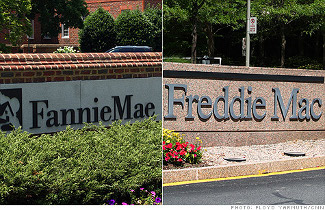
~ Click here to view the full Freddie and Fannie Become Penny Stocks article.
On July 23, when I and my Community Business segment were spiked from KPFA radio, Fannie Mae stock was trading at $15 and Freddie Mac stock was trading at $10.80, having both dropped from highs in the $60’s earlier this year. Fannie and Freddie at the time were both government sponsored enterprises.
In the segment that was scheduled on July 23, KPFA was going to use my new audio seminar, Positioning Your Assets for Growth in Uncertain Times for its fundraising. In our preparation, Dennis Bernstein had specifically asked me to address what was happening with Fannie Mae and Freddie Mac and the Congressional debate on the Housing and Economic Recovery Act of 2008.
The Positioning Your Assets audio seminar has a sample before and after portfolio. In the “before” portfolio, I show a portfolio that is invested in the “bubble economy” with significant investments in mortgage government sponsored enterprises. The “after” portfolio has no investments in mortgage government sponsored enterprises and represents an effort to shift out of unsustainable enterprises into investments in the “real economy” that are not dependent on federal government support.
When I was finally allowed back on KPFA radio on September 8th, Fannie Mae stock was trading at $0.73 and Freddie Mac was trading at $0.88.
Hence, from July 23 to September 8th, Fannie Mae and Freddie Mac common stock shareholders lost $15.3 billion and $6.4 billion, respectively. This includes CalPers, the largest California pension fund which held 4.2 million shares of of Fannie Mae and 3.9 million shares of Freddie Mac, losing approximately $100 million during this period. The California Teachers Retirement System does not publish their holdings. However, their losses on Fannie Mae and Freddie Mac’s failure were also likely to be significant.
During this period, Fannie Mae and Freddie Mac were far from the only “bubble” economy or “real economy” investments to fall in value. Indeed, we are in a deflationary credit crunch, with many assets and investments falling in value. However, very few fell more than 90% in that six + week period—just the ones that I was being asked to talk about.
In the last 12 months, common stockholders have lost $100+ billion on Fannie Mae and Freddie Mac stock. Regional and small banks have also lost additional amounts on Fannie Mae and Freddie Mac preferred stock. It does make you wonder what smart money got out of these stocks while the uninformed money stayed invested.
If you think a free press is expensive to fund and maintain, count up the costs to you, your assets and your retirement savings of trying to live without one.
